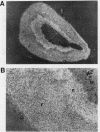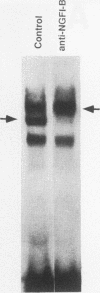Abstract
As part of its trophic action to maintain the steroidogenic capacity of adrenocortical cells, corticotropin (ACTH) increases the transcription of the cytochrome P-450 steroid hydroxylase genes, including the gene encoding steroid 21-hydroxylase (21-OHase). We previously identified several promoter elements that regulate 21-OHase gene expression in mouse Y1 adrenocortical tumor cells. One of these elements, located at nucleotide -65, closely resembles the recognition sequence of the orphan nuclear receptor NGFI-B, suggesting that NGFI-B regulates this essential steroidogenic enzyme. To explore this possibility, we first used in situ hybridization to demonstrate high levels of NGFI-B transcripts in the adrenal cortex of the adult rat. In cultured mouse Y1 adrenocortical cells, treatment with ACTH, the major regulator of 21-OHase transcription, rapidly increased NGFI-B expression. Gel mobility shift and DNase I footprinting experiments showed that recombinantly expressed NGFI-B interacts specifically with the 21-OHase -65 element and identified one complex formed by Y1 extracts and the 21-OHase -65 element that contains NGFI-B. Expression of NGFI-B significantly augmented the activity of the intact 21-OHase promoter, while mutations of the -65 element that abolish NGFI-B binding markedly diminished NGFI-B-mediated transcriptional activation. Specific mutations of NGFI-B shown previously to impair either DNA binding or transcriptional activation diminished the effect of NGFI-B coexpression on 21-OHase expression. Finally, an oligonucleotide containing the NGFI-B response element conferred ACTH response to a core promoter from the prolactin gene, showing that this element is sufficient for ACTH induction. Collectively, these results identify a cellular promoter element that is regulated by NGFI-B and implicate NGFI-B in the transcriptional induction of 21-OHase by ACTH.
Full text
PDF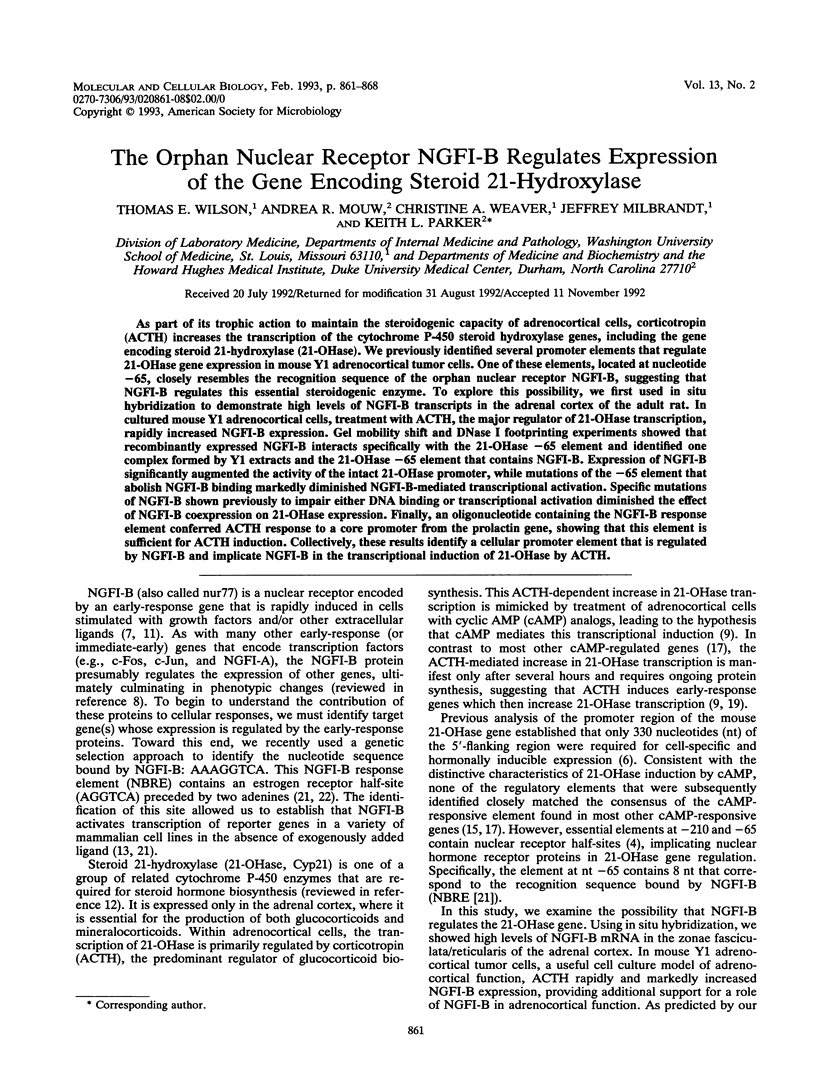
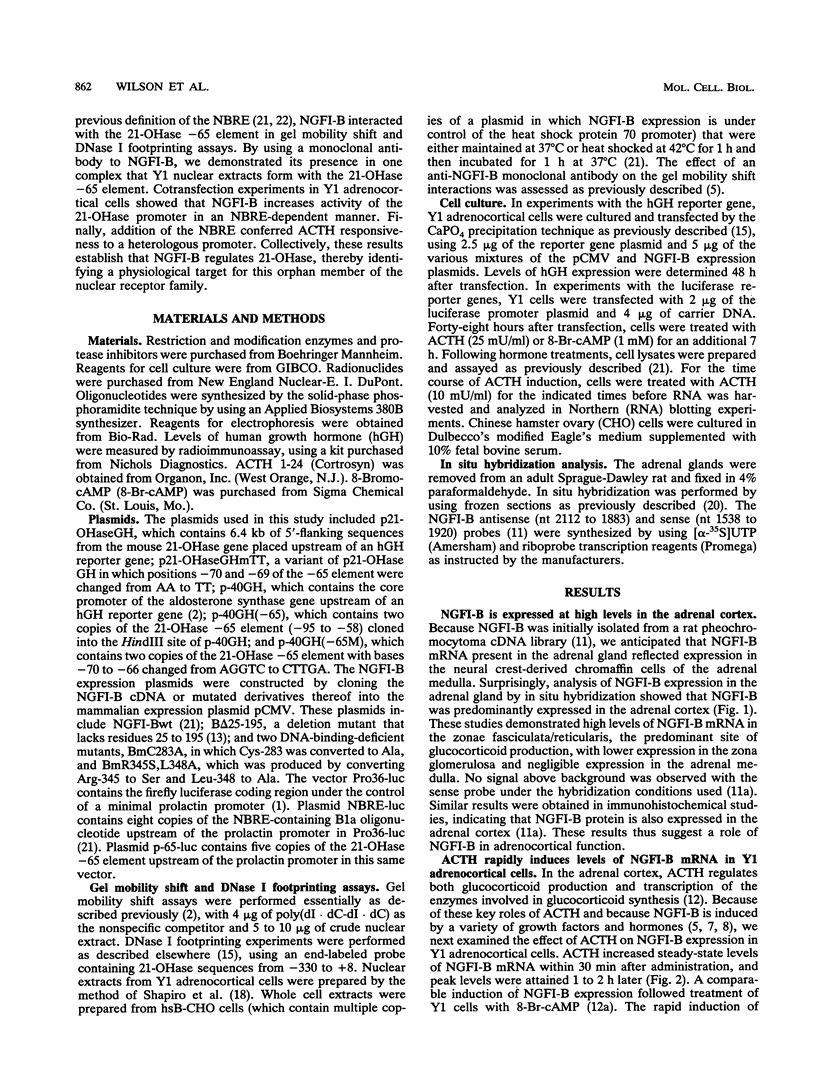
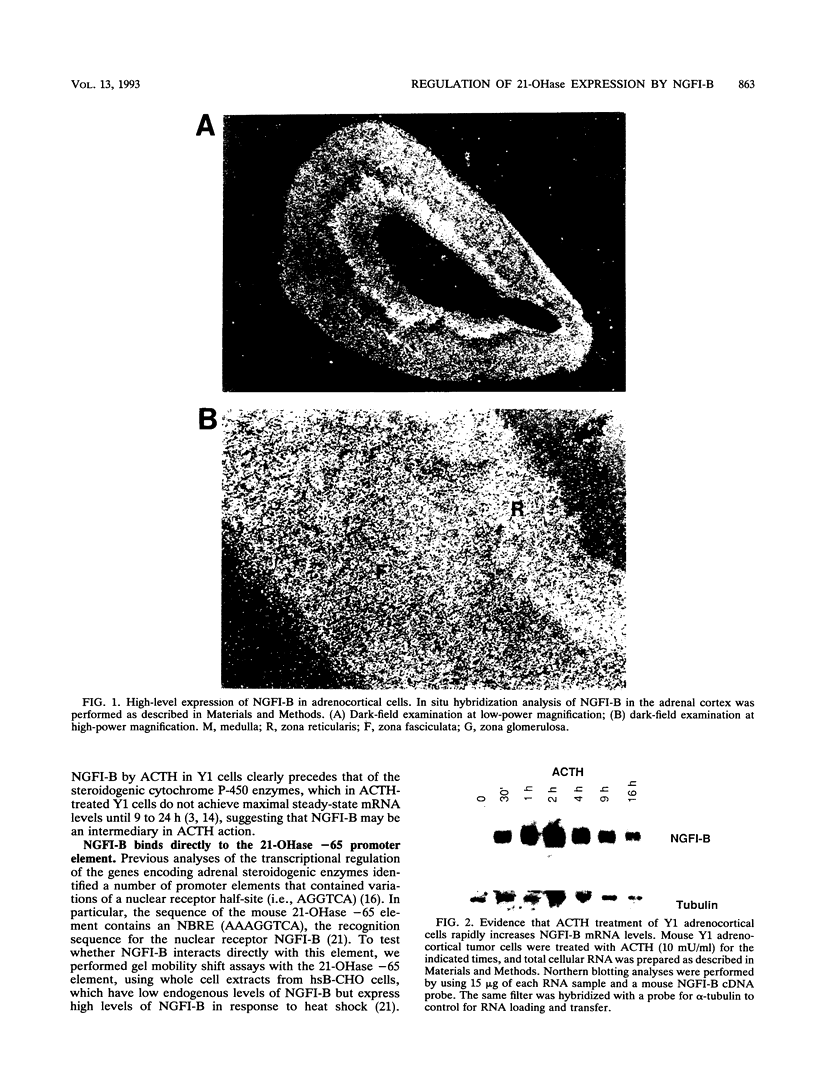
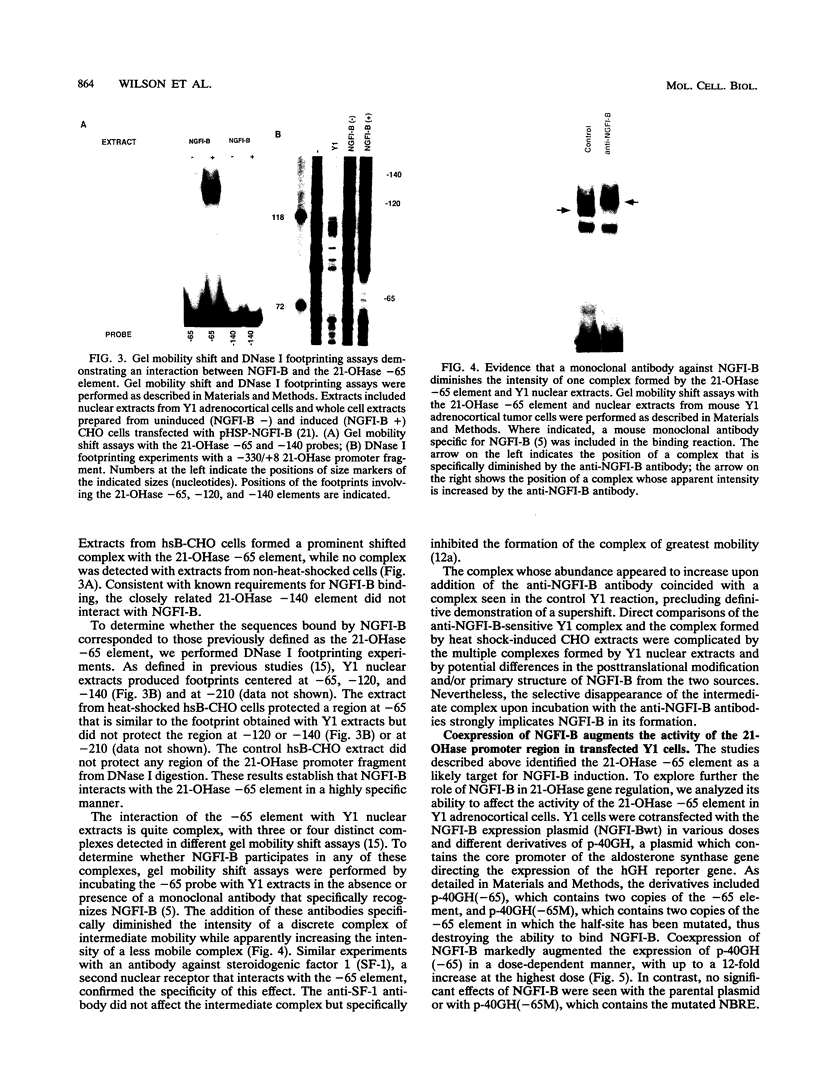
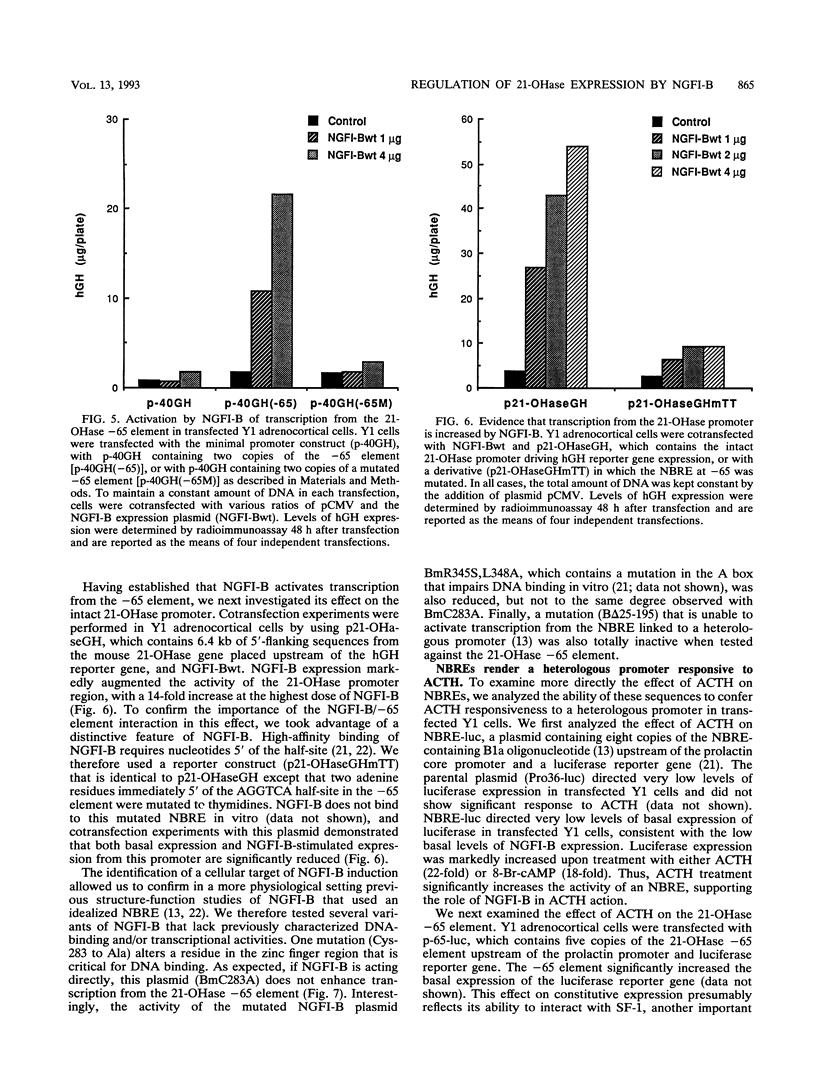
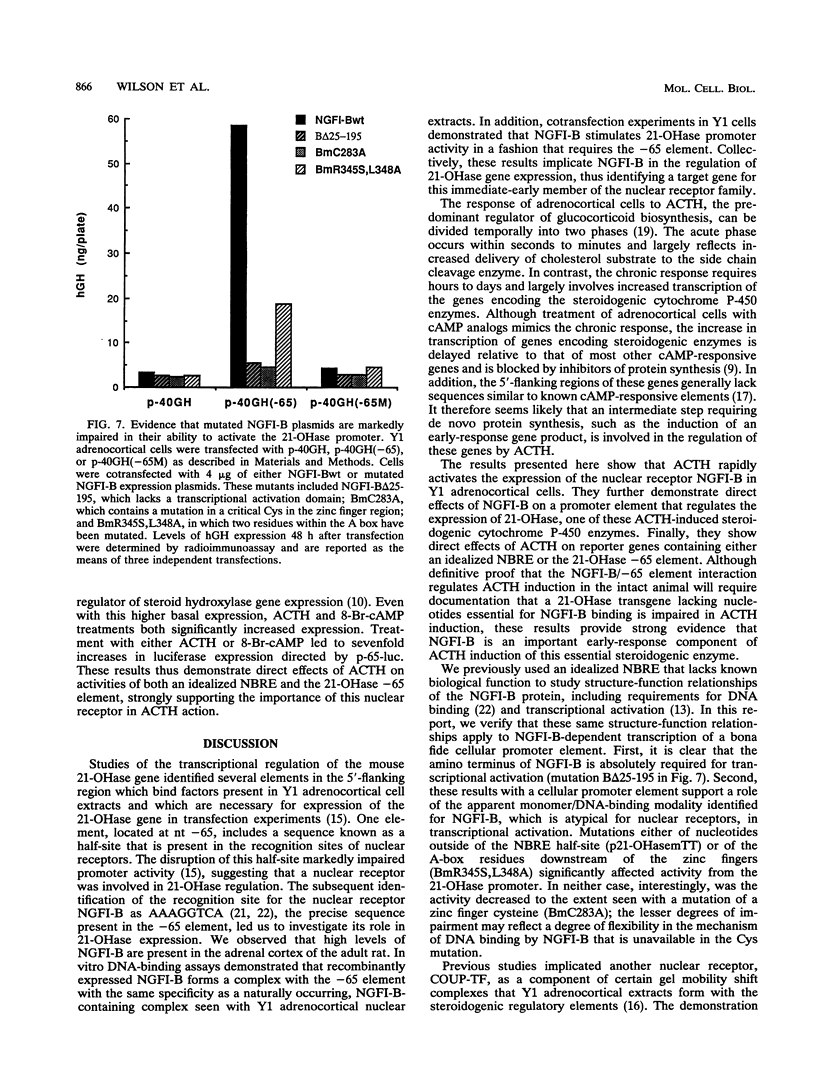
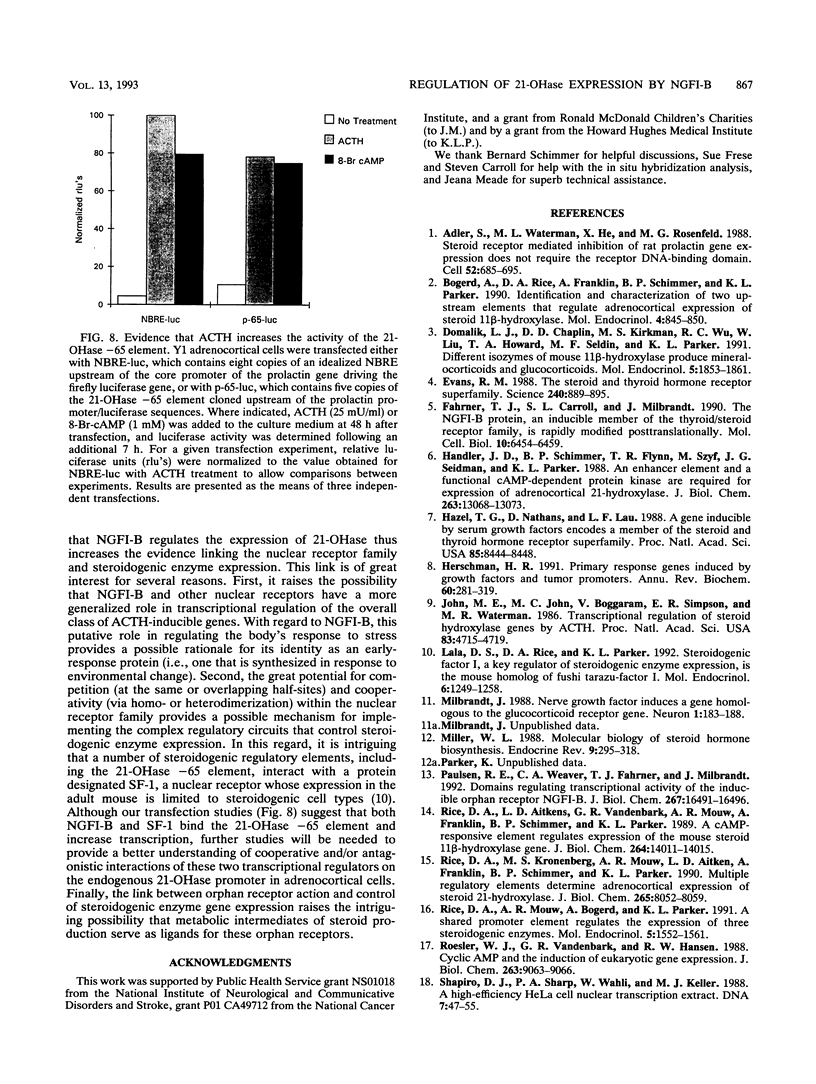

Images in this article
Selected References
These references are in PubMed. This may not be the complete list of references from this article.
- Adler S., Waterman M. L., He X., Rosenfeld M. G. Steroid receptor-mediated inhibition of rat prolactin gene expression does not require the receptor DNA-binding domain. Cell. 1988 Mar 11;52(5):685–695. doi: 10.1016/0092-8674(88)90406-0. [DOI] [PubMed] [Google Scholar]
- Bogerd A. M., Franklin A., Rice D. A., Schimmer B. P., Parker K. L. Identification and characterization of two upstream elements that regulate adrenocortical expression of steroid 11 beta-hydroxylase. Mol Endocrinol. 1990 Jun;4(6):845–850. doi: 10.1210/mend-4-6-845. [DOI] [PubMed] [Google Scholar]
- Domalik L. J., Chaplin D. D., Kirkman M. S., Wu R. C., Liu W. W., Howard T. A., Seldin M. F., Parker K. L. Different isozymes of mouse 11 beta-hydroxylase produce mineralocorticoids and glucocorticoids. Mol Endocrinol. 1991 Dec;5(12):1853–1861. doi: 10.1210/mend-5-12-1853. [DOI] [PubMed] [Google Scholar]
- Evans R. M. The steroid and thyroid hormone receptor superfamily. Science. 1988 May 13;240(4854):889–895. doi: 10.1126/science.3283939. [DOI] [PMC free article] [PubMed] [Google Scholar]
- Fahrner T. J., Carroll S. L., Milbrandt J. The NGFI-B protein, an inducible member of the thyroid/steroid receptor family, is rapidly modified posttranslationally. Mol Cell Biol. 1990 Dec;10(12):6454–6459. doi: 10.1128/mcb.10.12.6454. [DOI] [PMC free article] [PubMed] [Google Scholar]
- Handler J. D., Schimmer B. P., Flynn T. R., Szyf M., Seidman J. G., Parker K. L. An enhancer element and a functional cyclic AMP-dependent protein kinase are required for expression of adrenocortical 21-hydroxylase. J Biol Chem. 1988 Sep 15;263(26):13068–13073. [PubMed] [Google Scholar]
- Hazel T. G., Nathans D., Lau L. F. A gene inducible by serum growth factors encodes a member of the steroid and thyroid hormone receptor superfamily. Proc Natl Acad Sci U S A. 1988 Nov;85(22):8444–8448. doi: 10.1073/pnas.85.22.8444. [DOI] [PMC free article] [PubMed] [Google Scholar]
- Herschman H. R. Primary response genes induced by growth factors and tumor promoters. Annu Rev Biochem. 1991;60:281–319. doi: 10.1146/annurev.bi.60.070191.001433. [DOI] [PubMed] [Google Scholar]
- John M. E., John M. C., Boggaram V., Simpson E. R., Waterman M. R. Transcriptional regulation of steroid hydroxylase genes by corticotropin. Proc Natl Acad Sci U S A. 1986 Jul;83(13):4715–4719. doi: 10.1073/pnas.83.13.4715. [DOI] [PMC free article] [PubMed] [Google Scholar]
- Lala D. S., Rice D. A., Parker K. L. Steroidogenic factor I, a key regulator of steroidogenic enzyme expression, is the mouse homolog of fushi tarazu-factor I. Mol Endocrinol. 1992 Aug;6(8):1249–1258. doi: 10.1210/mend.6.8.1406703. [DOI] [PubMed] [Google Scholar]
- Milbrandt J. Nerve growth factor induces a gene homologous to the glucocorticoid receptor gene. Neuron. 1988 May;1(3):183–188. doi: 10.1016/0896-6273(88)90138-9. [DOI] [PubMed] [Google Scholar]
- Miller W. L. Molecular biology of steroid hormone synthesis. Endocr Rev. 1988 Aug;9(3):295–318. doi: 10.1210/edrv-9-3-295. [DOI] [PubMed] [Google Scholar]
- Paulsen R. E., Weaver C. A., Fahrner T. J., Milbrandt J. Domains regulating transcriptional activity of the inducible orphan receptor NGFI-B. J Biol Chem. 1992 Aug 15;267(23):16491–16496. [PubMed] [Google Scholar]
- Rice D. A., Aitken L. D., Vandenbark G. R., Mouw A. R., Franklin A., Schimmer B. P., Parker K. L. A cAMP-responsive element regulates expression of the mouse steroid 11 beta-hydroxylase gene. J Biol Chem. 1989 Aug 25;264(24):14011–14015. [PubMed] [Google Scholar]
- Rice D. A., Kronenberg M. S., Mouw A. R., Aitken L. D., Franklin A., Schimmer B. P., Parker K. L. Multiple regulatory elements determine adrenocortical expression of steroid 21-hydroxylase. J Biol Chem. 1990 May 15;265(14):8052–8058. [PubMed] [Google Scholar]
- Rice D. A., Mouw A. R., Bogerd A. M., Parker K. L. A shared promoter element regulates the expression of three steroidogenic enzymes. Mol Endocrinol. 1991 Oct;5(10):1552–1561. doi: 10.1210/mend-5-10-1552. [DOI] [PubMed] [Google Scholar]
- Roesler W. J., Vandenbark G. R., Hanson R. W. Cyclic AMP and the induction of eukaryotic gene transcription. J Biol Chem. 1988 Jul 5;263(19):9063–9066. [PubMed] [Google Scholar]
- Shapiro D. J., Sharp P. A., Wahli W. W., Keller M. J. A high-efficiency HeLa cell nuclear transcription extract. DNA. 1988 Jan-Feb;7(1):47–55. doi: 10.1089/dna.1988.7.47. [DOI] [PubMed] [Google Scholar]
- Simpson E. R., Waterman M. R. Regulation of the synthesis of steroidogenic enzymes in adrenal cortical cells by ACTH. Annu Rev Physiol. 1988;50:427–440. doi: 10.1146/annurev.ph.50.030188.002235. [DOI] [PubMed] [Google Scholar]
- Wanaka A., Johnson E. M., Jr, Milbrandt J. Localization of FGF receptor mRNA in the adult rat central nervous system by in situ hybridization. Neuron. 1990 Sep;5(3):267–281. doi: 10.1016/0896-6273(90)90164-b. [DOI] [PubMed] [Google Scholar]
- Wilson T. E., Fahrner T. J., Johnston M., Milbrandt J. Identification of the DNA binding site for NGFI-B by genetic selection in yeast. Science. 1991 May 31;252(5010):1296–1300. doi: 10.1126/science.1925541. [DOI] [PubMed] [Google Scholar]
- Wilson T. E., Paulsen R. E., Padgett K. A., Milbrandt J. Participation of non-zinc finger residues in DNA binding by two nuclear orphan receptors. Science. 1992 Apr 3;256(5053):107–110. doi: 10.1126/science.1314418. [DOI] [PubMed] [Google Scholar]



